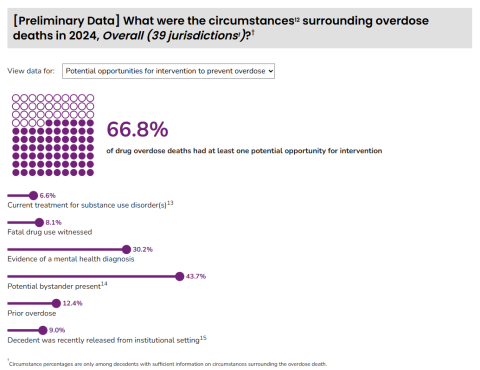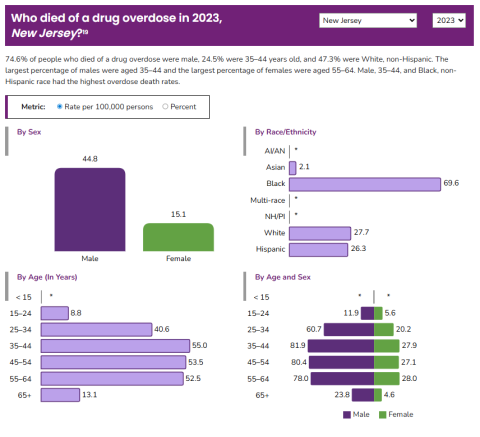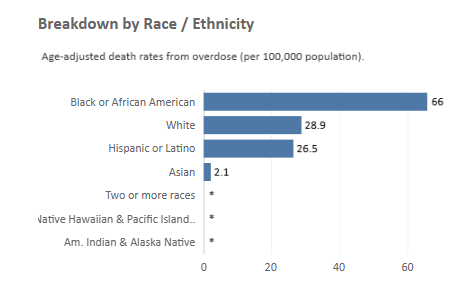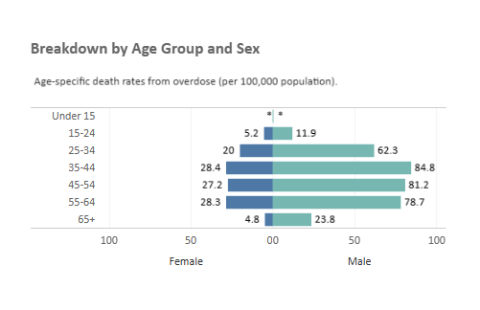You are here
On tough days, Kelly Pinzon is reminded of what her boss once explained to her.
“This is the worst day of a person's life, and we're reading their story, and we're honoring what happened with them.”
As a data abstractor in the New Jersey Department of Health, it is Pinzon’s job to log data from death certificates, coroner/medical examiner reports and toxicology reports in the Centers for Disease Control and Prevention (CDC)'s State Unintentional Drug Overdose Reporting System (SUDORS). When overdose deaths occur, Pinzon receives raw reports and inputs them to SUDORS and the related National Violent Death Reporting System (NVDRS), flagging trends and correlations–like the relationship between a history of mental health problems and the occurrence of a fatal overdose. Data collected through SUDORS, including location and the characteristics and circumstances surrounding a drug overdose death, inform both state and local prevention and response efforts.

| 
|
(L) Preliminary 2024 SUDORS data showing the circumstances surrounding overdoses in the United States.
(R) Final 2023 SUDORS data of the demographics of people who died of a drug overdose in New Jersey.
A criminology major in college, Pinzon was drawn to using data to help behind the scenes in the fight against overdose deaths.
“When I talked to my boss about the program, I could see how passionate she was about what data can do,” explained Pinzon. “It sounded really rewarding, but very intense. I watched Law & Order growing up, so I figured I’d be okay.”
Pinzon's work is part of the CDC Foundation’s Expanding Capacity and Partnerships to Address the Drug Overdose Epidemic program, which supports more than 200 field staff across the country as part of CDC’s Overdose Data to Action (OD2A) program.
“We synthesize information from multiple data sources and use it to get the data points that give us the whole picture,” said Pinzon. “Investigation of the scene, the condition of the body, information from family that was interviewed related to circumstances, past history, like medical and social history—we use all that information to write a narrative.”
And Pinzon’s work has had a major impact on community response.
Daniel Vega, RN, CCRN, MICN, CSM is a nurse manager and an emergency medical services (EMS) coordinator at University Hospital in Newark, NJ. When an overdose occurs, Vega’s team coordinates the response, often administering naloxone–an over-the-counter nasal spray designed to quickly reverse the effects of an opioid overdose by restoring breathing.
The data have been instrumental in guiding us.
A study showed that, in New Jersey, most people who are given naloxone decline to go to the hospital following the overdose. This meant that first responders were often the only healthcare professionals to interact with them. Recognizing the role communities could play in responding to overdoses, the University Hospital EMS team saw this as an opportunity to teach community members in neighborhoods where overdoses were occurring about how to administer naloxone in an overdose situation.

| 
|
New Jersey SUDORS data breakdown by race/ethnicity (L) and age group and sex (R).
Using SUDORS’ demographic breakdowns of opioid overdoses in Newark, Vega’s team determined which individuals and communities would benefit from directed, tailored outreach. They then partnered with community-based organizations, like the Newark Community Street Team, who ride along with EMS teams, acting as peer advocates and providing follow-up services and resources to people who overdosed.
“The data have been instrumental in guiding us,” said Vega. Seeing that African American men ages 45-64 were much more represented in the data, the team shaped their outreach to meet the needs of this demographic. “It has informed the services that we provide because we’re letting the community essentially tell us what they need.”
Daniel Vega (left) with his team and their community partners.
The EMS team responding to a call. Photo courtesy of Donald Jackson.
A member of the EMS team demonstrating correct use of naloxone during a community event.
Although Newark continues to see high rates of opioid-related deaths, the data are making a difference. In February 2025, CDC announced preliminary data showing a nearly 27 percent decline in the number of overdose deaths in the United States in 2024, compared to 2023—a drop driven largely by strategic distribution of naloxone. New Jersey has seen an almost 32 percent drop in overdose deaths, an encouraging indication that the work of people like Kelly Pinzon and Daniel Vega is having an impact in the hardest-hit communities.
“That our little data on the computer screen is being used for something so big–and it's effective–wow,” Pinzon said. “We really are doing something.”
Data snapshots courtesy of CDC's SUDORS data dashboard.
This article is supported by the Centers for Disease Control and Prevention (CDC) of the U.S. Department of Health and Human Services (HHS) as part of a financial assistance award totaling $17,000,000, with 100 percent funded by CDC/HHS. A portion of this funding supported the project described above. The contents are those of the author(s) and do not necessarily represent the official views of, nor an endorsement by, CDC/HHS, the U.S. Government, or the CDC Foundation.
